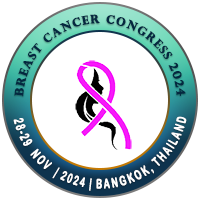.png)
Rainer Frentzel Beyme
University of Bremen, GermanyTitle: Occupational dioxin-exposure of women and breast cancer risk
Abstract
The observation, that women are included in epidemiologic studies at a low rate if occupational cancer is concerned has been depicted in a recent article from Hohenadel, et al. [1]. That review addressed the issue by comparing two-time periods of the pertinent literature from1991-2009. Women became considered with proportions increasing from 39% in publications appearing 1991-1995 to 62% in 2006-2009 in articles that assessed risk estimates including likelihood requirements such as dose-response relationships. The fact that also after that second period articles appeared such as the astonishing publication of the experience of the Italian National Cancer Institute at Naples by Capasso, et al. [2] wondering about the risk of breast cancer affected by the ‘metabolic syndrome’ (MS) in postmenopausal women without adequate studies of the environmental and occupational hazards of cases and controls seems to throw light on the fact how diverse the approaches still are. Ignoring the well documented toxic exposures in the Naples area by waste incineration at Calvi Risorta the authors suggested that several evidences indicate an association between MS and breast cancer, primarily owing to insulin resistance and low serum HDL-C. Lacking was any scientific attempt to relate the metabolic disturbance to toxic effects from most probable dioxin exposure as a cause of endocrine disturbances from nearby massive particle emanations in the most affected region of Naples.
To show the need of follow-up studies into environmental research the following report is related to epidemiologic controlled studies addressing occupational risk factors indicating the increased breast cancer risk in women exposed to Hexachlorocyclohexane (HCH) and PCDDs in the chemical plant producing Lindane (gamma-HCH) until the closure of the site in 1984 [3].
The report is based on an occupational cluster of lethal malignancies related to epidemiologic controlled studies addressing occupational risk factors. Epidemiology is an observational science reconstructing unplanned natural experiments among defined human populations exposed towards environmental hazards. Various reports on cancer risk among men who were occupationally exposed to polychlorinated hydrocarbons containing PCDD and PCDF, in particular the dioxin TCDD have associated their cancer promoting effects given primary carcinogenic exposures. Mostly male workers - having been employed in chemical factories producing chlorinated pesticides - have contributed to the understanding of the role of polychlorinated dioxins as promoting factors under the condition that relevant initiating carcinogenic risk factors were present as necessary precursors. Nevertheless, the overall risk and especially mortality as a fatal clinical outcome are determined by the additional effect of promotors like the halogenated compounds such as PCDDs.
Epidemiological mortality studies showing elevated numbers of cancer deaths with confirmed diagnoses of their causes of death began in the 1960ies. A cohort study carried out after an accident in November 1953 at the BASF plant in Ludwigshafen, Germany, by the follow-up involving about 180 directly affected men, of whom only the core group was enlisted, because of re compensation claims [4]. The next follow-up after 40 years [5] of the same cohort was included in the European study on cancer mortality in workers exposed to chlorophenoxy herbicides and chlorophenols, which reported by 1991 an increased risk for male breast cancer (SMR 345, [6]).
Biography
To be updated soon.

